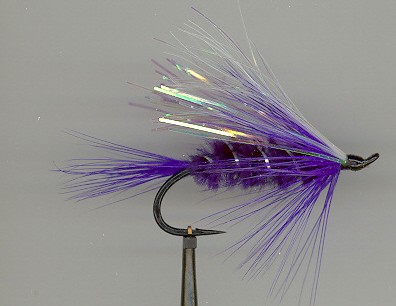On The Fly
"Fly tying is a school from which we never graduate"
 TYING NEWS
TYING NEWS
The Southern Oregon Fly Tiers met Thursday, July 28th at the library in Gold Hill.
It was great to have Morris Fruitman and Joe Holzen back after both recovered from surgery. Rusty Randall
challenged the group with another one of his mystery flies. There was a fly raffle and fly exchange along
with demonstrations. Join us the fourth Thursday of each month for more fun and the sharing of the art.
Attention all tiers!! The steelhead tournament and auction are coming up soon. How about tying up a dozen of your favorite steelhead pattern and donating them to a very worthy cause? It's the best way for us to support our own club. For donation forms or to drop off your flies, contact Johnny Hale or myself by phone or see us at a meeting.
 PATTERN OF THE MONTH - Street Walker
PATTERN OF THE MONTH - Street Walker
Hook Steelhead, up eye, sizes 2 - 8.
Thread Black, 6/0.
Tail Purple hackle fibers.
Rib Fine silver tinsel.
Body Purple chenille.
Hackle Purple.
Wing Pearl Flashabou.
Tying Instructions:
1) Start the thread at a position on the hook shank that allows the proper room for the head.
Use this as a marker and don't tie anything past this mark. Wrap a thread base back to a position
just above the hook point.
2) Tie in a small number of hackle fibers, ½ shank length, for the tail.
3) Tie in the tinsel rib and the chenille body material at this same position.
4) Wrap the chenille forward and tie it in at the marker.
5) Wrap the tinsel forward in 5 even turns, then tie it off at the marker.
6) Tie in the purple hackle feather and wrap 4-5 turns, wet style. The barbs of the hackle should reach
the point of the hook.
7) Tie in a bunch of Flashabou, one shank length, for the wing. Position the Flashabou so it ties in front
of, and up against the material tied in at the marker. This should create the desired wing angle of 30
degrees.
8) Form a neat head, whip finish, and cement.
The Streetwalker, originated by Gordon Nash in the 1980s, is a summer steelhead pattern. It is probably a variation of the traditional Purple Peril, using a Flashabou wing instead of squirrel tail. Under low light of dawn, dusk or an overcast day in the fall, it suggests a presence in the water, with just enough flash to be tempting but not too much to scare the fish off. A very effective pattern throughout the west, it also has been used as an attractor pattern for trout.
Gordon Nash, a knowledgeable Deschutes River guide and tier, originally liked to dress the fly on a nickel-plated hook. This would give the dark pattern even more attracting flash. With thousands of steelhead patterns to choose from and a never-ending variety of colors available, you should remember the old adage, "Bright day, bright fly, dark day, dark fly." Because most successful summer steelhead fishing occurs in times of low light, dark patterns, like the Streetwalker, are most effective. You should choose more subdued flies for lower, clearer water, and brighter days.
When restocking your summer steelhead fly box, you should take a look at some of the traditional patterns and don't rule out Atlantic Salmon flies. They are often deadly on steelhead. So tie some up, give them a test flight, and let me know how you do.
TYING TIPS - Thread Ribs
This pattern uses Flashabou for the wing. When tying dozens of flies at a time,
folding and cutting flash material into exact lengths is very cumbersome and time consuming. Rusty Randall
taught me a trick that makes this step easy and efficient. Just gather up the size bundle you need, then
grab the bundle near the zip tie with an electronic test clip or hackle pliers. You are now in control. Now
tie in the flash by the loose ends, pull back, and cut to length. You are still in control for the next fly.
I will demonstrate this at the next meeting.
Tie One On,
Dan Kellogg
(you can contact me at FLYGUY@EZNORTHWEST.COM)